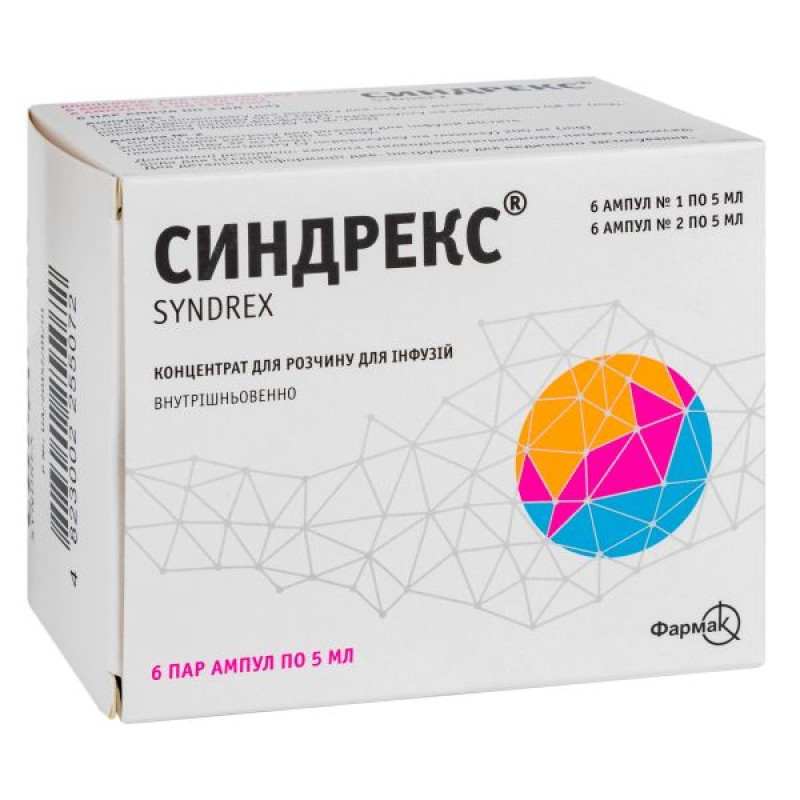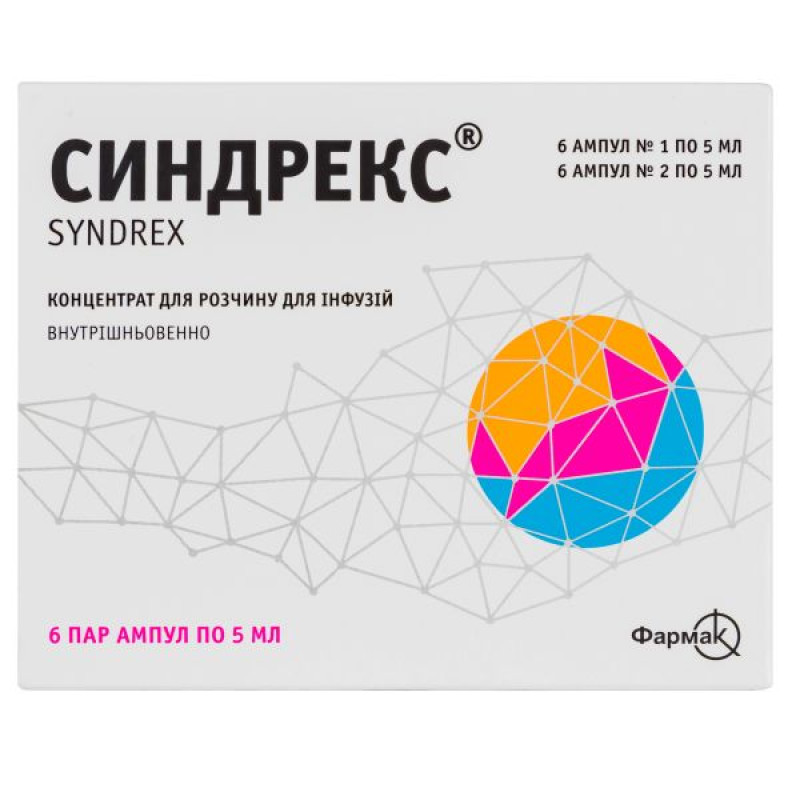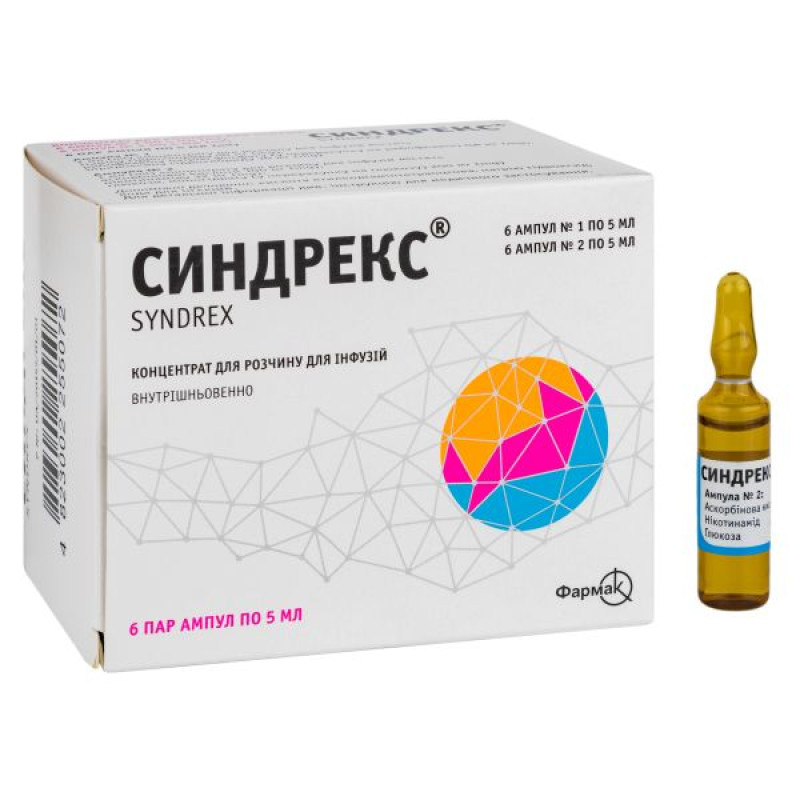Syndrex concentrate for infusion solution, 5 ml ampoules, 3 ampoules No. 1 and No. 2

Instructions Syndrex concentrate for solution for infusions ampoules 5 ml, 3 pieces each ampoules No. 1 and ampoules No. 2
Composition
Ampoule No. 1
active ingredients: thiamine hydrochloride, riboflavin, pyridoxine hydrochloride;
1 ml of concentrate for solution for infusion contains thiamine hydrochloride 50 mg, riboflavin sodium phosphate (calculated as riboflavin) 0.8 mg, pyridoxine hydrochloride 10 mg;
Excipients: ethylenediaminetetraacetic acid, sodium hydroxide, water for injections.
Ampoule No. 2
active ingredients: ascorbic acid, nicotinamide, glucose;
1 ml of concentrate for solution for infusion contains ascorbic acid 100 mg; nicotinamide 32 mg; glucose, monohydrate (calculated as glucose) 200 mg;
Excipients: ethylenediaminetetraacetic acid, sodium hydroxide, water for injections.
Dosage form
Concentrate for solution for infusion.
Main physicochemical properties: clear yellow liquid.
Pharmacotherapeutic group
B vitamin complex with vitamin C.
ATX code A11E B.
Pharmacological properties
Pharmacodynamics.
The drug Syndrex®, concentrate for solution for infusion, contains vitamins B1, B2, B6, nicotinamide and vitamin C.
Pharmacokinetics.
No data.
Indication
Use in adults and children for rapid treatment of severe deficiency or malabsorption of water-soluble vitamins B and C:
in alcoholism, when severe thiamine depletion can lead to Wernicke's encephalopathy;
after acute infectious diseases;
in the postoperative period;
in case of psychotic states.
Also used to maintain vitamin B and C levels in patients undergoing chronic intermittent hemodialysis.
Contraindication
Hypersensitivity to the active or auxiliary substances of the medicinal product.
Interaction with other medicinal products and other types of interactions
When used simultaneously with levodopa, pyridoxine may affect its effects.
Application features
Although potentially serious allergic adverse reactions, such as anaphylactic shock, may occur rarely during or shortly after parenteral administration of Syndrex®, their occurrence should not preclude the use of Syndrex® in patients who require treatment, especially those at risk of developing Wernicke's encephalopathy. Treatment of such patients with parenteral thiamine is essential.
Initial signs of a reaction to Syndrex® are sneezing or mild asthma. Subsequent injections in such patients may cause anaphylactic shock. Facilities for the treatment of anaphylactic reactions should be available at the time of each intravenous injection of Syndrex®. To minimize the risk of such events with intravenous administration, Syndrex® should be administered by infusion over 30 minutes.
This medicinal product is intended for intravenous infusion only and should not be administered by any other route.
Syndrex® should only be administered intravenously – there have been reports of inadvertent administration by the wrong route; these cases were not associated with serious adverse reactions.
Visually inspect ampoules before use and do not use if particles are present in the solution.
Sodium
This medicinal product contains 2.86 mmol (65.78 mg) sodium per 1 pair of ampoules (ampoule No. 1+ampoule No. 2). Caution should be exercised when used in patients on a controlled sodium diet.
Use during pregnancy or breastfeeding
When used for clinical indications at recommended doses, no side effects have been reported.
Animal studies on reproductive toxicity are insufficient. The potential risk to humans has not been established.
The drug should be prescribed with caution to pregnant women.
Ability to influence reaction speed when driving vehicles or other mechanisms
No studies on the effects on the ability to drive and use machines have been conducted. Given the composition of the medicinal product, no effects are expected.
Method of administration and doses
For intravenous use.
Adults and elderly patients:
rapid therapy for severe deficiency or malabsorption of water-soluble vitamins B and C, especially in alcoholism, where severe thiamine deficiency can lead to Wernicke's encephalopathy
| 10 ml of solution ampoule No. 1 | + | 10 ml of solution ampoule No. 2 |
| or | ||
| 15 ml of solution ampoule No. 1 | + | 15 ml of solution ampoule No. 2 |
2–3 pairs of 5 ml ampoules (1 pair = ampoule No. 1 + ampoule No. 2) should be diluted in 50–100 ml of infusion solution (saline solution or 5% glucose), the infusion should be carried out for 30 minutes every 8 hours or as prescribed by a doctor.
psychosis after anesthesia or ECT (electroconvulsive therapy); intoxication in acute infections
| 5 ml of solution ampoule No. 1 | + | 5 ml of solution ampoule No. 2 |
Dilute 1 pair of 5 ml ampoules in 50–100 ml of infusion solution (saline solution or 5% glucose), infuse for 30 minutes 2 times a day for 7 days.
hemodialysis
Dilute 1 pair of 5 ml ampoules in 50–100 ml of infusion solution (saline solution or 5% glucose), infuse for 30 minutes once every two weeks at the end of dialysis.
For children:
Syndrex® is rarely indicated for children, the permissible doses are listed below:
up to 6 years 6–10 years 10–14 years from 14 years old | 1/4 dose for adults 1/3 of the adult dose from 1/2 to 2/3 of the adult dose dose as for adults |
Method of application
Dilute before use.
Syndrex®, concentrate for solution for infusion for intravenous administration, should be administered by drip infusion. Equal volumes of the contents of ampoules No. 1 and No. 2 are added to 50–100 ml of physiological saline or 5% glucose solution and administered over 30 minutes.
Compatibility
The drug Syndrex® is compatible with the following infusion solutions: glucose 5%, saline solution (sodium chloride 0.9%), glucose 4.3% with sodium chloride 0.18%, glucose 5% with potassium chloride 0.3%, sodium lactate.
The chemical and physical stability of Syndrex® at room temperature is shown in the table below:
| Solvent | Time in the light, hours |
| Glucose 5% | 7 |
| Saline solution (sodium chloride 0.9%) | 7 |
| Glucose 4.3% with sodium chloride 0.18% | 4 |
| Glucose 5% with potassium chloride 0.3% | 4 |
| Sodium lactate | 7 |
Solutions are expected to be stable for a longer period of time if protected from light.
Children.
The drug Syndrex® is indicated for administration to children (see the section “Method of administration and dosage”).
Overdose
In unlikely cases of overdose, symptomatic and supportive therapy is provided.
Adverse reactions
Adverse reactions reported as possibly related to the use of the medicinal product are listed in the table below. Adverse reactions are listed by system organ class and frequency: very common (>1/10); common (>1/100, <1/10); uncommon (>1/1000, <1/100); rare (>1/10000, <1/1000); very rare (<1/10000), including isolated reports; not known (cannot be estimated from the available data).
The frequency of adverse reactions reported during post-marketing use cannot be estimated as they are derived from spontaneous reports and are therefore classified as unknown.
| Systems | Frequency | Adverse reaction |
| On the part of the immune system | Unknown | Hypersensitivity (including anaphylaxis, rash and urticaria) |
| From the nervous system | Unknown | Paresthesia |
| Cardiovascular system | Unknown | Hypotension |
| General disorders and administration site conditions | Unknown | Injection site reactions (including pain and swelling) |
Reporting of suspected adverse reactions
Reporting adverse reactions after the registration of a medicinal product is important. This allows monitoring of the benefit/risk ratio when using this medicinal product. Medical and pharmaceutical professionals, as well as patients or their legal representatives, should report all cases of suspected adverse reactions and lack of efficacy of the medicinal product via the Automated Information System for Pharmacovigilance at the link: https://aisf.dec.gov.ua.
Expiration date
2 years.
From a microbiological point of view, this product should be used immediately. If not used immediately, in-use storage times and conditions prior to use are the responsibility of the user and would normally not be longer than 24 hours at 2 to 8°C, unless dilution has taken place in controlled and validated aseptic conditions.
Storage conditions
Store in the original packaging at a temperature not exceeding 25 °C. Do not freeze.
The diluted solution should not be frozen.
Keep out of reach of children.
Incompatibility.
This medicinal product must not be mixed with other medicinal products except those mentioned in the section "Method of administration and dosage".
Packaging
5 ml in an ampoule.
3 ampoules No. 1 (thiamine hydrochloride + riboflavin + pyridoxine hydrochloride) in a blister.
3 ampoules No. 2 (ascorbic acid + nicotinamide + glucose) in a blister.
2 blisters of ampoules No. 1 and 2 blisters of ampoules No. 2 in a pack.
Vacation category
According to the recipe.
Producer
JSC "Farmak".
Location of the manufacturer and address of its place of business.
Ukraine, 04080, Kyiv, Kyrylivska St., 74.
There are no reviews for this product.
There are no reviews for this product, be the first to leave your review.
No questions about this product, be the first and ask your question.










